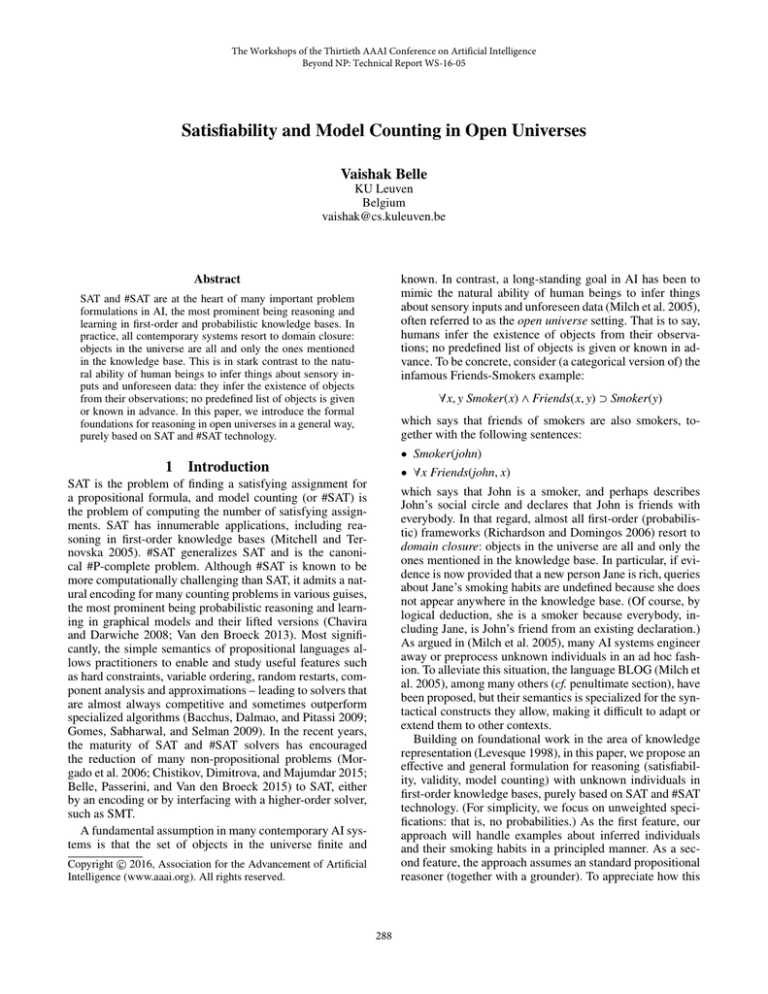
The Workshops of the Thirtieth AAAI Conference on Artificial Intelligence
Beyond NP: Technical Report WS-16-05
Satisfiability and Model Counting in Open Universes
Vaishak Belle
KU Leuven
Belgium
vaishak@cs.kuleuven.be
Abstract
known. In contrast, a long-standing goal in AI has been to
mimic the natural ability of human beings to infer things
about sensory inputs and unforeseen data (Milch et al. 2005),
often referred to as the open universe setting. That is to say,
humans infer the existence of objects from their observations; no predefined list of objects is given or known in advance. To be concrete, consider (a categorical version of) the
infamous Friends-Smokers example:
SAT and #SAT are at the heart of many important problem
formulations in AI, the most prominent being reasoning and
learning in first-order and probabilistic knowledge bases. In
practice, all contemporary systems resort to domain closure:
objects in the universe are all and only the ones mentioned
in the knowledge base. This is in stark contrast to the natural ability of human beings to infer things about sensory inputs and unforeseen data: they infer the existence of objects
from their observations; no predefined list of objects is given
or known in advance. In this paper, we introduce the formal
foundations for reasoning in open universes in a general way,
purely based on SAT and #SAT technology.
∀x, y Smoker(x) ∧ Friends(x, y) ⊃ Smoker(y)
which says that friends of smokers are also smokers, together with the following sentences:
• Smoker(john)
1
Introduction
• ∀x Friends(john, x)
SAT is the problem of finding a satisfying assignment for
a propositional formula, and model counting (or #SAT) is
the problem of computing the number of satisfying assignments. SAT has innumerable applications, including reasoning in first-order knowledge bases (Mitchell and Ternovska 2005). #SAT generalizes SAT and is the canonical #P-complete problem. Although #SAT is known to be
more computationally challenging than SAT, it admits a natural encoding for many counting problems in various guises,
the most prominent being probabilistic reasoning and learning in graphical models and their lifted versions (Chavira
and Darwiche 2008; Van den Broeck 2013). Most significantly, the simple semantics of propositional languages allows practitioners to enable and study useful features such
as hard constraints, variable ordering, random restarts, component analysis and approximations – leading to solvers that
are almost always competitive and sometimes outperform
specialized algorithms (Bacchus, Dalmao, and Pitassi 2009;
Gomes, Sabharwal, and Selman 2009). In the recent years,
the maturity of SAT and #SAT solvers has encouraged
the reduction of many non-propositional problems (Morgado et al. 2006; Chistikov, Dimitrova, and Majumdar 2015;
Belle, Passerini, and Van den Broeck 2015) to SAT, either
by an encoding or by interfacing with a higher-order solver,
such as SMT.
A fundamental assumption in many contemporary AI systems is that the set of objects in the universe finite and
which says that John is a smoker, and perhaps describes
John’s social circle and declares that John is friends with
everybody. In that regard, almost all first-order (probabilistic) frameworks (Richardson and Domingos 2006) resort to
domain closure: objects in the universe are all and only the
ones mentioned in the knowledge base. In particular, if evidence is now provided that a new person Jane is rich, queries
about Jane’s smoking habits are undefined because she does
not appear anywhere in the knowledge base. (Of course, by
logical deduction, she is a smoker because everybody, including Jane, is John’s friend from an existing declaration.)
As argued in (Milch et al. 2005), many AI systems engineer
away or preprocess unknown individuals in an ad hoc fashion. To alleviate this situation, the language BLOG (Milch et
al. 2005), among many others (cf. penultimate section), have
been proposed, but their semantics is specialized for the syntactical constructs they allow, making it difficult to adapt or
extend them to other contexts.
Building on foundational work in the area of knowledge
representation (Levesque 1998), in this paper, we propose an
effective and general formulation for reasoning (satisfiability, validity, model counting) with unknown individuals in
first-order knowledge bases, purely based on SAT and #SAT
technology. (For simplicity, we focus on unweighted specifications: that is, no probabilities.) As the first feature, our
approach will handle examples about inferred individuals
and their smoking habits in a principled manner. As a second feature, the approach assumes an standard propositional
reasoner (together with a grounder). To appreciate how this
c 2016, Association for the Advancement of Artificial
Copyright Intelligence (www.aaai.org). All rights reserved.
288
• M |= φ1 ∧ φ2 iff M |= φi for i ∈ {1, 2};
• M |= ∀xφ(x) iff M |= φ(a) for all a ∈ U;
• M |= (a = b) iff a and b are the same parameters.
We say that φ is valid iff for every L+ -model M, M |= φ.
It is worth noting that when first-order logic is restricted
to a class of models with a fixed countably infinite domain,
the compactness property does not hold (Smullyan 1995).
For example, the theory (Levesque 1998):
{∃xP(x), ¬P(#1), ¬P(#2), . . .}
is an unsatisfiable theory whose every finite subset is indeed
satisfiable.
latter feature is approached, consider the following alternative for unknowns: fix an extremely large set of constants
in advance; since an agent has a finite life, it will only encounter finitely many individuals during its operation, and
so, at any moment if it were to encounter a new individual,
assign this individual’s identity to an unused constant. While
such a proposal would work, it requires us to initially ground
the knowledge base wrt all constants, which is very expensive. To counter this, a central property of our approach is
that any given time, grounding only needs to consider the
known individuals and a small number of unknowns. In the
long term, our proposal can benefit from existing translations of combinatorial problems to SAT and #SAT, and in
this regard, we believe this work would also provide the basis for exploring further questions in AI and machine learning over open universes in a principled way.
We are organized as follows. We begin with the logical
preliminaries, and first consider satisfiability and validity in
open universes. Next, we turn to how model counting should
be defined in open universes. Finally, we discuss related
work and conclude.
2
Knowledge Bases
Since reasoning in full first-order logic is undecidable, it is
natural to assume that the knowledge bases are restricted to
a specified form. Our intent here is to capture (and go beyond) existing AI examples, such as the Friends-Smokers
domain. To that end, we consider an expressive first-order
fragment called proper+ knowledge bases (Lakemeyer and
Levesque 2002), equivalent to a (possibly infinite) set of
ground clauses.
In the sequel, we use e to range over ewffs, that is,
quantifier-free formulas whose only predicate is equality.
For example, x , john and (x , john ∧ x , jane) are
ewffs. Moreover, by a clause we simply mean a quantifierfree disjunction of (possibly non-ground) atoms. For example, Human(john) and Human(x) ∨ Vehicle(x) are clauses.
We use c to range over clauses. Finally, we write ∀φ to mean
the universal closure of φ. For example, ∀(Friends(x, y) ∨
Brothers(x, y)) denotes ∀x, y. Friends(x, y) ∨ Brothers(x, y).
Definition 1: A formula of the form ∀(e ⊃ c) is called a
∀-clause. A knowledge base φ is proper+ if it is a finite nonempty set of ∀-clauses.
Here are some examples for the Friends-Smokers domain:
• Friends(john, jane) ⊃ ¬Smoker(john) says that if John is
Jane’s friend, then he is not a smoker;
• ∀(¬Smoker(x) ∨ ¬Friends(x, y) ∨ Smoker(y)) captures, as
usual, that friends of smokers are smokers themselves;
• ∀(x , john ⊃ Smoker(x)) says that everybody other than
John is a smoker;
• ∀((x , john ∧ x , jane) ⊃ ¬Smoker(x)) says that everybody other than John and Jane are not smokers.
• ∀(e ⊃ Smoker(x)) ∧ ∀(¬e ⊃ ¬Smoker(x)), where e = (x =
john ∨ x = jane) says that John and Jane are the only ones
in the universe who smoke, thus enabling the closed world
assumption.
In the context of logical and probabilistic reasoning, it is
often the case that one provides evidence and queries. We
assume that both evidence and queries are quantifier and
variable-free formulas (i.e., ground atoms + Boolean connectives). With this assumption, given a proper+ KB φ, and
evidence or query α, clearly φ ∧ (¬)α is also a proper+ KB.2
Preliminaries
Logical Background
We let L be a classical propositional language over the vocabulary Q = {p, q, . . .}. A L-model M is a {0, 1} assignment
to the elements of Q. For any φ ∈ L, we write M |= φ to
mean that φ is satisfied at M, defined inductively as usual
(Smullyan 1995). We write Q(φ) to refer to the propositions
mentioned in φ. By extension, we write L(φ) to mean the
(finite) language built from Q(φ), and write M(φ) to refer to
the set of L(φ)-models where φ is satisfied. (That is, L(φ)models are {0, 1} assignments to the elements of Q(φ).)
We let L+ be a first-order language with equality, relational symbols {P(x), Q(x, y), R(x, y, z), . . . , P0 (x), . . .} of every arity, variables {x, y, z, . . .}, and a countably infinite set
of parameters U = {#1, #2, . . .} (Levesque 1984) serving as
the domain of discourse for quantification. (For presentation,
we often use identifiers such as Latin alphabets (a, b, . . .) and
proper names (john, jane, . . .) as parameters.) Together with
equality, parameters essentially realize an infinitary version
of the unique name assumption.1 The set of (ground) atoms
is obtained as:
Q+ = P(a1 , . . . , ak ) | P is a predicate, ai a parameter .
A L+ -model M is a {0, 1} assignment to the elements of Q+ .
The semantics for φ ∈ L+ is defined as usual with equality
as identity:
• M |= p iff p ∈ Q+ and M[p] = 1;
• M |= ¬φ iff M 6|= φ;
1
Such a feature can also be enabled in ordinary first-order logic
by following the recipe in (Levesque 1998). Note that this does
not rule out capturing uncertainty about the identity of objects, as
needed, for example, in (Srivastava et al. 2014), which can be enabled in a first-order language using complex terms. (Indeed, (Srivastava et al. 2014) also resort to the device of rigid designators in
the underlying logic.) We ignore these concerns for simplicity.
In the case of entailment, we check whether φ ∧ ¬α is unsatisfiable. When α denotes evidence or query in probabilistic contexts,
we are often interested in the model count of φ ∧ α.
2
289
3
Satisfiability and Validity
This theorem rests on an important observation made in
(Levesque 1998) and elsewhere (Levesque and Lakemeyer
2001) that parameters not mentioned in the theory behave is
a similar fashion. Of course, Proposition 2, Theorem 3 and
our semantic setup can be used to further show:
Before addressing model counting, we first begin with the
fundamental tasks of automating satisfiability and validity
checking in L+ .3 We use the following notation in our results:
• θ denotes a substitution of variables with parameters, as
applicable to ewffs and clauses. For any set of parameters
C ⊆ U, we write θ ∈ C to mean substitutions are only
allowed wrt the parameters in C.
For example, given θ = hx 7→ john, y 7→ janei, ewff e =
x , bob, and clause c = Friends(x, y) ∨ Siblings(x, y), we
have eθ = john , bob and cθ = Friends(john, jane) ∨
Siblings(john, jane). If C = {john, bob}, clearly θ < C.
Instead, θ0 = hx 7→ john, y 7→ bobi is one such that θ0 ∈ C.
• gnd(φ) = {cθ | ∀(e ⊃ c) ∈ φ and |= eθ} .
Recall that because equality is understood as identity for parameters, things john , jane are valid,
and things like john , john are unsatisfiable. So,
given φ = ∀(x , john ⊃ Smoker(x)), we have
gnd(φ) = {Smoker(jane),
Smoker(bob), . . .}. More pre
cisely gnd(φ) = Smoker(a) | a , john is a parameter .
• For k ≥ 0, gnd(φ, k) = {cθ | ∀(e ⊃ c) ∈ φ, |= eθ, θ ∈ K},
where K is the set of parameters mentioned in φ plus k
(arbitrary) new ones.
For example, if φ = {∀(Smoker(x)), Smoker(john)}, then
gnd(φ, 1) = {Smoker(john), Smoker(jane)}. (Note that the
parameter jane is picked arbitrarily.) Also, gnd(φ, 0) =
{Smoker(john)} . Instead, if φ0 = ∀(Smoker(x)), then
gnd(φ0 , 0) is simply the empty set.
• Suppose φ is proper+ such that the maximum number of
variables mentioned in a ∀-clause is k. We define gnd(φ, ∗)
to mean gnd(φ, k). For example, if φ = ∀(Smoker(x))
then gnd(φ, ∗) = gnd(φ, 1) and if φ = ∀(Smoker(x)) ∧
∀(Friends(x, z)) then gnd(φ, ∗) = gnd(φ, 2).
Proposition 2: For any proper+ KB φ, gnd(φ, ∗) is finite.
The first hurdle is addressing the compactness property,
or the lack thereof. Such a property is useful to draw conclusions about a possibly infinite theory in terms of its finite
subsets. As mentioned, L+ does not enjoy this property, but
fortunately, proper+ knowledge bases do. For our first main
result, we have:
Theorem 3: Suppose φ is a proper+ KB. Then S = gnd(φ) is
satisfiable iff every finite subset of S is satisfiable.
The reason why this theorem holds is because gnd(φ) is
essentially a (possibly infinite) propositional theory over a
(possibly infinite) vocabulary. Compactness from propositional logic is then imported.
The second main result of this section is to then address
logical consequence for proper+ KBs in a finitary manner:
Theorem 4: Suppose φ is a proper+ KB, and suppose α is
a quantifier and variable-free formula (i.e., ground atoms +
Boolean connectives). Then
Corollary 5: gnd(φ, ∗) is satisfiable (or unsatisfiable) in L+
iff it is satisfiable (or unsatisfiable resp.) in classical (finitary) propositional logic.
In sum, with these results, after grounding the knowledge
base wrt a few extra parameters, an ordinary SAT solver can
be used.
To see Theorem 4 in action, suppose φ is the union of the
following:
• ∀(Smoker(x) ∧ Friends(x, y) ⊃ Smoker(y))
• Smoker(john)
• ∀y(Friends(john, y))
Suppose the query α = Smoker(jane). Then gnd(φ∧¬α, ∗) =
gnd(φ ∧ ¬α, 2), i.e., we are to consider the parameters in
φ ∧ ¬α plus 2 new ones, say C = {jane, john, bob, rob} . On
applying all possible substitutions θ ∈ C, gnd(φ ∧ ¬α, ∗)
would include, among other things:
• Smoker(john) ∧ Friends(john, jane) ⊃ Smoker(jane)
• Smoker(john)
• Friends(john, jane)
together with ¬α = ¬Smoker(jane). Clearly gnd(φ ∧ ¬α, ∗)
is unsatisfiable, and so |= φ ⊃ α.
In the above example, bob and rob could have been done
away with, and so one might wonder why these extra parameters are needed for grounding. To see that, consider φ0
as the union of:
• ∀(x , john ⊃ Smoker(x))
• ∀(Friends(x, y))
• ∀(Smoker(x) ∧ Friends(x, y) ⊃ Smoker(y))
That is, all we know is that everyone other than John is a
smoker, everybody is friends with everybody else, and the
usual Friends-Smokers claim. In fact, by deduction, |= φ0 ⊃
Smoker(john). This is because some person other than John,
say Jane, is declared to be a smoker and since she is friends
with John, he must also be a smoker. However, grounding φ0
wrt the only parameter mentioned in φ0 , namely john, would
not lead to a propositional theory where Smoker(john) can
be deduced. Instead, consider gnd(φ0 , ∗) = gnd(φ0 , 2) and
parameters {john, jane, bob} does lead to a grounding where
Smoker(john) is entailed, as desired.
4
Model Counting
We now finally turn to model counting. The key question
we attempt to answer is this: how should model counting be
defined in an open universe setting?
Consider the classical definition (Gomes, Sabharwal, and
Selman 2009). Let φ be a propositional formula. Then the
model count of φ, written #φ, is defined as:
|= φ ⊃ α iff gnd(φ ∧ ¬α, ∗) is unsatisfiable.
3
The investigations in this section simplify and improve on results in (Belle and Lakemeyer 2011).
#φ = |M(φ)|
290
Strong Model Counting
Recall that, even though L is infinite, we define M(φ) to
be the set of satisfying interpretations of φ, which are {0, 1}
assignments to Q(φ) where φ is true.4
In an open universe setting, given a proper+ KB φ and
query α, which possibly mentions hereto unknown individuals, a reasonable definition for the model count of the
proper+ KB ψ = φ ∧ α is:
#ψ = #gnd(ψ, ∗)
= |M(gnd(ψ, ∗))|
(Note that the RHS is a propositional formula as usual.) This
definition is intuitive in the sense that it accounts for all the
individuals currently encountered and a few arbitrary unknowns corresponding to the quantifier rank of a ∀-clause
in ψ. On the one hand, note that if ψ does not mention any
∀-clauses, i.e., ψ is a ground formula, the definition is equivalent to the classical one. On the other, if ψ does mention
∀-clauses but is unsatisfiable, from Theorem 4, #ψ = 0 as
desired.
To see this definition in action, let φ be the union of:
• ∀(Smoker(x) ∨ Alcoholic(x))
• ∀(x , john ⊃ ¬Smoker(x))
which says that everybody is a smoker or an alcoholic, and
everybody other than John is not a smoker. Suppose we are
interested in contrasting two queries in terms of their counts:
let α1 = Alcoholic(jane) and α2 = Smoker(jane). Consider
that gnd(φ ∧ α1 , ∗) is the conjunction of:
• (Smoker(john) ∨ Alcoholic(john)) ∧ (Smoker(jane) ∨
Alcoholic(jane)) ∧ (Smoker(bob) ∨ Alcoholic(bob))
• ¬Smoker(jane) ∧ ¬Smoker(bob)
• Alcoholic(jane)
where the grounding is wrt the parameters in φ ∧ α1 , namely
{john, jane} plus one extra one (because φ mentions one variable), namely bob. Clearly models can vary in how they interpret Smoker(john) ∨ Alcoholic(john), and so we obtain
a count of 3. However, φ ∧ α2 is inconsistent, and indeed
#gnd(φ ∧ α2 , ∗) = 0.
By extension, given a proper+ KB φ and a query α, the
probability of the query given the KB is defined as:
#gnd(φ ∧ α, ∗)
PRφ (α) =
#gnd(φ ∧ α, ∗) + #gnd(φ ∧ ¬α, ∗)
It is easy to see that if |= φ ⊃ α, then φ ∧¬α is not satisfiable,
and so #gnd(φ∧¬α, ∗) must be 0. Therefore, PRφ (α) is 1 and
PRφ (¬α) is 0.
For example, letting φ be the sentences above saying that
everyone is a smoker or an alcoholic, and everybody other
than John in not a smoker, we see that PRφ (Smoker(jane)) =
0 and PRφ (¬Smoker(jane)) = PRφ (Alcoholic(jane)) = 1.
More generally, for any new parameter a , john that has
not been hereto encountered, we obtain PRφ (Alcoholic(a)) =
1, as one would expect.
The above notion considers the situation of knowing some
individuals, encountering unknowns via observations, and
making claims thereof. It is natural to investigate a generalization wrt the entire domain of discourse: can anything
be said about the count of one query, regardless of individuals that will be encountered in the future? To that end, we
introduce the notion of strong model counting for a proper+
KB φ, denoted ##φ, defined as:
##φ = lim #gnd(φ, n)
n→∞
We argue for the reasonableness of this definition using
mathematical intuition and examples:
• Suppose φ is any finite set of ground clauses. Clearly, for
any k ≥ 0, gnd(φ, k) = φ and so ##φ = #φ as usual.
• Suppose φ = ∀(Smoker(x)). Then gnd(φ, 1) =
{Smoker(john)}, and for the language consisting of a single proposition Smoker(john) there are two interpretations, one where the proposition is false and another
where it is true. So |M(Smoker(john))| = 1. Going further,
gnd(φ, 2) = {Smoker(john), Smoker(jane)}. While there
are 4 interpretations for a language with 2 propositions,
clearly |M(Smoker(john) ∧ Smoker(jane))| = 1. Thus, for
any k, |M(gnd(φ, k))| = 1, and so ##φ = 1.
• Suppose φ = ∀(Smoker(x) ∨ Alcoholic(x)). Then
gnd(φ, 1) = {Smoker(john) ∨ Alcoholic(john)}, which has
3 models. By extension, gnd(φ, k) = 3k models. Thus,
##φ = limn→∞ 3n , which is not bounded.
Along the lines of the Smoker-Alcoholic example, ##φ
will be uninteresting for most interesting knowledge bases.
Despite this drawback, we argue that this definition makes
sense from a mathematical point of view, and the fact that
counts can be unbounded is natural and not at all surprising.
So where do we go from here?
Consider the generalization to PR for the case of strong
model counting:
PRLIMφ (α) = lim
n→∞
#gnd(φ ∧ α, n)
#gnd(φ ∧ α, n) + #gnd(φ ∧ ¬α, n)
which says that the limit is considered for the ratio of the
model counts for φ ∧ α versus for that of φ ∧ α and φ ∧ ¬α.
To see a simple example, consider the query α =
Alcoholic(jane), and let the KB be φ = ∀(Smoker(x) ∨
Alcoholic(x)) ∧ ¬Smoker(jane). Then #gnd(φ ∧ α, ∗) = 3,
and for any n ≥ 1, we observe that #gnd(φ ∧ α, n) = 3n . Of
course, #gnd(φ ∧ ¬α, n) = 0. In that vein, we observe that
3n
= 1.
n→∞ 3n
PRLIMφ (α) = lim
4
In certain situations, given a finite set of propositions Q0 ⊂ Q,
we might be interested in the model count of a formula φ wrt all the
propositions in Q0 and not just the ones in φ. Given our definition
of #φ, this is achieved as follows: let Q00 be the propositions in Q0
but not in φ. Let γ = {p ∨ ¬p | p ∈ Q00 } . Clearly, φ ≡ φ ∧ γ, and
using our construction, we would compute #(φ ∧ γ).
Naturally, PRLIMφ (¬α) = 0.
Thus, when strong model counting is studied in terms of
PRLIM, the limit of the ratio allows us to better understand
the probabilities of one query against another.
291
5
and Levesque 2002), where proper+ KB were first introduced, and (Belle and Lakemeyer 2011), where a result
closely related to Theorem 4 was considered. However, both
(Levesque 1998) and (Lakemeyer and Levesque 2002) were
concerned with sound but incomplete deductive reasoning.
Model counting, SAT and #SAT formulations were not considered in any of these. We also remark that while there is
extensive literature on decidable classes of first-order fragments (Lewis 1980), results such as Theorem 3 are somewhat different in flavor because they are simply establishing
compactness in the presence of a countably infinite domain.
In the related area of database theory, handling incomplete
information has been a longstanding goal (Van der Meyden
1998), the most prominent approach being that of labelled
null values, which is connected to the problem of query containment (Chandra and Merlin 1977). Basically, nulls can be
seen as Skolem constants, that is, these are objects in the
universe whose identity is unknown. Nonetheless, the universe is assumed to be finite and fixed in database theory. A
treatment of nulls in the context of (Levesque 1998) appears
in (Giacomo, Lespérance, and Levesque 2011).
In the related area of automated verification, SMT (Barrett et al. 2009) investigates the satisfiability of (usually)
quantifier-free decidable first-order theories, such as linear arithmetic. Although there is a lot of recent interest
in model counting for SMT (Ma, Liu, and Zhang 2009;
Chistikov, Dimitrova, and Majumdar 2015; Belle, Passerini,
and Van den Broeck 2015), the focus is on formulas of the
form x ≤ y+3, where ≤ is a distinguished predicate, and + is
a distinguished function that are interpreted in the usual way.
Thus, it is not clear if any of these techniques can be borrowed for examples such as Friends-Smokers with domainspecific predicates and quantification. Nonetheless, there is
some research on obtaining algebraic expressions for model
counts in SMT (see, for example, (Luu et al. 2014)), and so
investigating these connections is worthwhile.
In the probability and machine learning circles, in practice, it is most often that probabilistic graphical models
and their lifted versions make the finite domain closure assumption (Richardson and Domingos 2006; Van den Broeck
2013). Nonetheless, handling unknowns has been an important concern, perhaps best demonstrated in the early
work of (Charniak and Goldman 1993) on unbounded objects for hypothesized plans. More generally, a common
approach in many probabilistic models is to admit number uncertainty, where an explicit generating function determines (at run time) the number of objects, and the modeling language allows such a function together with statements made about these instantiated objects. This is reflected in, for example, BLOG (Milch et al. 2005) and distributional clauses (Gutmann et al. 2011). Closely related
is the approach taken in (Laskey 2008), where the existence of named objects is determined by a distinguished
identity function. In similar spirit, the existence (and number) of objects can be determined by explicit logical constraints in (Koller and Pfeffer 1998; Pasula et al. 2002;
Getoor et al. 2001). A slightly more involved approach is to
admit referential uncertainty, as in (Srivastava et al. 2014),
where different logical terms might denote the same ob-
Discussion
Our account of #φ was motivated by our account of satisfiability in countably infinite domains, all of which was
achieved using a few parameters outside those mentioned in
φ. Our account of ##φ was an attempt to understand model
counting wrt the set of all parameters. Finally, when counting was considered as a ratio, we observed that PR and
PRLIM are 1 for queries that are entailed, and 0 for those
that are inconsistent with the knowledge base.
Although all of this was investigated in the context of
grounding a proper+ KB, ##φ and PRLIM are closely related to a classical study in model theory called 0-1 laws.
Given a logical language L, a class of L-structures M, a
property of structures P, let µn (P) denote the fraction of Lstructures of domain size n that satisfy P. The logic is said
to have the 0-1 law if µ(P) limn→∞ µn (P) is either 0 or
1. Fagin (1976) proved a 0-1 law for first-order logic. In recent work, Beame et al. (2015) revisit this from the viewpoint of first-order model counting. The first-order model
counting problem is this: given a first-order formula φ, and
a number n ∈ N, compute the number of first-order structures of size n (up to isomorphism) where φ holds. Basically, if a closed-form algebraic expression could be obtained for φ and n, then simplifications using calculus alone
would yield µ(φ). For example, for a language with two
unary predicates Smoker(x) and Alcoholic(x), the first-order
model count for φ = ∀(Smoker(x) ∨ Alcoholic(x)) is 3n ,
and so, µ(φ) = limn→∞ 3n /4n = 0. Unfortunately, Beame
et al. (2015) show that such a program is not possible in
general: they obtain a first-order formula whose first-order
model counting problem is #P1 -complete (Valiant 1979).
Putting it all together, we make the following observations, which we leave as directions for future work:
• The proof for the #P1 -completeness of the first-order
model counting problem in (Beame et al. 2015) is based
on an encoding of a Turing machine that computes a #P1 hard function as first-order sentences. Without going into
the details, the syntax of proper+ KBs, however, does not
permit expressing some of these sentences in an obvious way (e.g., existential quantifiers from the outside are
not allowed). Thus, does the hardness result also apply to
proper+ KBs?
• Extending the previous question, can computing PRφ (α),
which is easy, inform us about PRLIMφ (α)?
6
Related Work
This paper is concerned with extending model counting to
open universes in a general way, best represented by the
Friends-Smokers-Jane example in Section 1. At the outset,
we remark that although there is a large body of literature
on open universes, none have attempted to formulate this
in terms of SAT and #SAT. We divide the literature into
two broad camps: the logic camp, which includes knowledge representation and databases, and the probability camp,
which includes open-universe Bayesian models.
In the logic circles, as we mentioned, our work is
based on foundational work in knowledge representation
(Levesque 1998), and its derivatives, including (Lakemeyer
292
References
ject in the universe; see (Milch et al. 2005; Srivastava et
al. 2014) for comprehensive discussions. At the other extreme, approaches such as (Singla and Domingos 2007;
Doshi et al. 2011) exploit a locality property over an infinite set of variables, in the sense that all variables other than
the ones in consideration are equivalent (in some appropriate formal sense). In a nutshell, the syntax and semantics
for these approach vary considerably, making it difficult to
adapt or extend them to other situations. To that end, by developing an open-universe account wrt SAT and #SAT, we
obtained a simple and clean framework that can perhaps also
be used to contrast and compare these accounts. Moreover,
to the best of our knowledge, none of the other proposals
have been shown to capture the entire range of examples in
this paper, especially in the sense of expressivity matching
that of proper+ KBs.
7
Bacchus, F.; Dalmao, S.; and Pitassi, T. 2009. Solving #SAT
and Bayesian inference with backtracking search. J. Artif.
Intell. Res. (JAIR) 34:391–442.
Barrett, C.; Sebastiani, R.; Seshia, S. A.; and Tinelli, C.
2009. Satisfiability modulo theories. In Handbook of Satisfiability. IOS Press. chapter 26, 825–885.
Beame, P.; Van den Broeck, G.; Gribkoff, E.; and Suciu, D.
2015. Symmetric weighted first-order model counting. In
PODS, 313–328. ACM.
Belle, V., and Lakemeyer, G. 2011. On progression and
query evaluation in first-order knowledge bases with function symbols. In Proc. IJCAI, 255–260.
Belle, V.; Passerini, A.; and Van den Broeck, G. 2015. Probabilistic inference in hybrid domains by weighted model integration. In IJCAI.
Chandra, A. K., and Merlin, P. M. 1977. Optimal implementation of conjunctive queries in relational data bases. In
STOC, 77–90.
Charniak, E., and Goldman, R. P. 1993. A bayesian model
of plan recognition. Artif. Intell. 64(1):53–79.
Chavira, M., and Darwiche, A. 2008. On probabilistic inference by weighted model counting. Artif. Intell. 172(67):772–799.
Chistikov, D.; Dimitrova, R.; and Majumdar, R. 2015. Approximate counting in smt and value estimation for probabilistic programs. In TACAS, volume 9035. 320–334.
Doshi, F.; Wingate, D.; Tenenbaum, J. B.; and Roy, N. 2011.
Infinite dynamic bayesian networks. In ICML, 913–920.
Fagin, R. 1976. Probabilities on finite models. The Journal
of Symbolic Logic 41(01):50–58.
Getoor, L.; Friedman, N.; Koller, D.; and Taskar, B. 2001.
Learning probabilistic models of relational structure. In
ICML, 170–177.
Giacomo, G. D.; Lespérance, Y.; and Levesque, H. J. 2011.
Efficient reasoning in proper knowledge bases with unknown individuals. In IJCAI, 827–832.
Gomes, C. P.; Sabharwal, A.; and Selman, B. 2009. Model
counting. In Handbook of Satisfiability. IOS Press.
Gutmann, B.; Thon, I.; Kimmig, A.; Bruynooghe, M.; and
De Raedt, L. 2011. The magic of logical inference in probabilistic programming. Theory and Practice of Logic Programming 11:663–680.
Koller, D., and Pfeffer, A. 1998. Probabilistic frame-based
systems. In AAAI/IAAI, 580–587.
Lakemeyer, G., and Levesque, H. J. 2002. Evaluation-based
reasoning with disjunctive information in first-order knowledge bases. In Proc. KR, 73–81.
Laskey, K. B. 2008. Mebn: A language for first-order
bayesian knowledge bases. Artif. Intell. 172(2-3):140–178.
Levesque, H., and Lakemeyer, G. 2001. The logic of knowledge bases. The MIT Press.
Levesque, H. J. 1984. Foundations of a functional approach
to knowledge representation. Artif. Intell. 23(2):155–212.
Conclusions
This paper was concerned with first-order knowledge bases
in open universes. More precisely, for so-called proper+
knowledge bases that allow universally quantified clauses,
where the domain of quantification is countably infinite, we
showed that SAT and #SAT technology can be leveraged.
Mainly, a ground version of the knowledge base wrt the
known individuals and a small number of unknowns was
shown to be sufficient for the tasks of satisfiability, validity and model counting. The topic was explored in a general way, and thus, we believe this work would also provide
the basis for exploring further questions in AI and machine
learning over open universes in a principled manner.
Outside of the foundational questions identified in Section
5, there are many interesting avenues for the future:
• Modern #SAT solvers appeal to caching components
(Bacchus, Dalmao, and Pitassi 2009) or to circuit compilation (Chavira and Darwiche 2008), which perform significantly better than full backtracking in a DPLL search
tree. However, if every subsequent query introduces a
new parameter, the knowledge base on which we perform
model counting would now include new clauses. How
component caching and knowledge compilation can be
adapted to handle this situation of changing knowledge
bases in an effective way (i.e., without a restart) is an interesting avenue for research.
• Extending and studying our results in a probabilistic context, where weights are accorded to logical sentences
(Richardson and Domingos 2006), would then allow us
to consider lifted graphical models in open universes.
• Finally, extending the logical language from propositions
to functions would allow us to handle applications requiring referential uncertainty, as in (Srivastava et al. 2014).
Acknowledgements
The author would like to thank the anonymous reviewers for
helpful suggestions and comments, and is supported by the
Research Foundation-Flanders (FWO-Vlaanderen).
293
Levesque, H. J. 1998. A completeness result for reasoning
with incomplete first-order knowledge bases. In Proc. KR,
14–23.
Lewis, H. R. 1980. Complexity results for classes of quantificational formulas. Journal of Computer and System Sciences 21(3):317 – 353.
Luu, L.; Shinde, S.; Saxena, P.; and Demsky, B. 2014. A
model counter for constraints over unbounded strings. In
ACM SIGPLAN Conference on Programming Language Design and Implementation, PLDI ’14, 565–576. New York,
NY, USA: ACM.
Ma, F.; Liu, S.; and Zhang, J. 2009. Volume computation
for boolean combination of linear arithmetic constraints. In
CADE, volume 5663 of LNCS. 453–468.
Milch, B.; Marthi, B.; Russell, S. J.; Sontag, D.; Ong, D. L.;
and Kolobov, A. 2005. BLOG: Probabilistic models with
unknown objects. In Proc. IJCAI, 1352–1359.
Mitchell, D. G., and Ternovska, E. 2005. A framework
for representing and solving NP search problems. In AAAI,
430–435.
Morgado, A.; Matos, P. J.; Manquinho, V. M.; and Silva, J.
P. M. 2006. Counting models in integer domains. In SAT,
410–423.
Pasula, H.; Marthi, B.; Milch, B.; Russell, S. J.; and Shpitser,
I. 2002. Identity uncertainty and citation matching. In NIPS,
1401–1408.
Richardson, M., and Domingos, P. 2006. Markov logic networks. Machine learning 62(1):107–136.
Singla, P., and Domingos, P. M. 2007. Markov logic in
infinite domains. In UAI, 368–375.
Smullyan, R. 1995. First-order logic. Dover Publications.
Srivastava, S.; Russell, S. J.; Ruan, P.; and Cheng, X. 2014.
First-order open-universe pomdps. In UAI, 742–751.
Valiant, L. G. 1979. The complexity of enumeration and
reliability problems. SIAM Journal on Computing 8(3):410–
421.
Van den Broeck, G. 2013. Lifted Inference and Learning in
Statistical Relational Models. Ph.D. Dissertation, KU Leuven.
Van der Meyden, R. 1998. Logical approaches to incomplete information: A survey. In Logics for databases and
information systems. Springer. 307–356.
294






